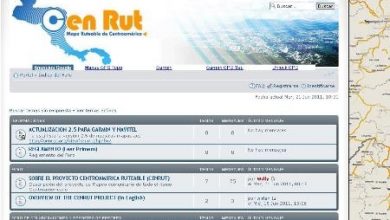Interview with Carlos Quintanilla - QGIS
We speak with Carlos Quintanilla, current president of the QGIS Association, who gave us his version on the increase in demand for professions related to geosciences, as well as what is expected of them in the future. It is not a secret that many technological leaders in many fields -construction, engineering, and others-, “TIG are transversal tools that are used by more and more sectors that see them as an effective tool to make decisions in those aspects that affect the territory, In the future we will see more and more companies that use TIG as a work tool, it will gradually become an office automation program that is increasingly common in work computers ”.
The inclusion of TIG in various areas, there is talk of the integration of disciplines to achieve consolidation of a project, so Quintanilla said that currently it is increasingly necessary the participation of experts in many disciplines that use TIG, architects, engineers , environmental, doctors, criminalists, journalists, etc.
In addition to the above, free GIS has had to adapt to respond to the needs that arise, and keep up with technological advances, free GIS are a guarantee for interoperability between applications and libraries, link directly with In a CRM, making use of an artificial intelligence library is already possible, and it is partly thanks to the fact that Free software programs are combined.
We know that the 4th digital age brings with it the goal of shaping smart cities in the near future. But, how does GIS allow effective management of smart cities? Smart cities will be when maximum interoperability is achieved between all applications, the implementation of a free GIS allows cities to be smart. Smart cities will be when the data is of quality and the tools are adapted to the needs of citizens.
Quintanilla, indicated that the BIM + GIS integration is not ideal, but it could be if there was communication between both worlds, it is necessary to get a BIM technology development team that knows the operation of GIS to be able to get them to coexist. The integration of both applications will bring benefits in the sense of savings by introducing geometry and attributes that come from the GIS and could be used in a BIM.
Likewise, seeing the global interest in the establishment of smart cities, we asked if the QGIS Association has developed any tool for this purpose. Quintanilla emphasized that he does not know of any tool that can be used to create smart cities, but QGIS and its more than 700 add-ons are, in themselves, an effective tool to have smart cities. The great advantage of QGIS over its competitors is the more than 700 add-ons that can be installed, apart from the large number of tools that QGIS already contains as standard. It is very easy to create new plugins that serve to better serve QGIS technicians and users.

About the acceptance and adoption of the QGIS Association products, the president made it clear to us that QGIS is free software and behind this community there are many companies, as new tools that affect the core of QGIS are decided in a technical committee, in which QGIS Spain has representation. While in plugins, creators have complete freedom to create whatever you need. From our association and all the others we have the objective of disseminating the QGIS program at conferences, presentations, and forums where professionals from the GIS sector meet. Showing the successes achieved is the best way to educate new users to use QGIS .
Regarding interoperability standards, Quintanilla stated that most of the standards come from the OGC (Open Geospatial Consortium), QGIS has the vocation to adapt to the default standards, so that it is very easy to follow them and improve interoperability between applications and servers. Some commercial programs by default use private formats and then adapt to standards, QGIS adapts to standards from the root, it comes innately. Perhaps map services (WMS, WFS, WFS-T,) are the most used, but there are others that are also important, metadata, data formats (gml, GPKG, etc.).
According to the use of mobile devices that provide very specific information on the user, which can harm or benefit the citizen and their environment, the president of the QGIS Association states that it is a double-edged sword when data is used fraudulently and without respect people's privacy. However, they are very interesting data, and always within the legal framework, they must be used for scientific and beneficial purposes for citizens. Open data, OpenData, is data that allows us to do many very interesting studies. OpenStreetMap would be a good example.
Additionally, we ask your impressions about the importance of programming for a GIS analyst in this 4th digital era. It depends on the definition of GIS analyst, if we define GIS analyst as the professional who must give answers to complex GIS problems, then Yes would be indispensable. However, if the analyst defines them as a professional who analyzes projects and makes decisions with a work team, then it is not essential that the analyst knows how to program, but someone from the team would be essential.
Although to be a good analyst, without being an expert programmer, it would be good to know the possibilities, the effort involved in assessing the work required to prepare tasks and thus make planning decisions for the proper development of projects.

It is not essential, but it is highly recommended, it is not necessary to program, there are many tools that can be executed without programming knowledge, but in relatively complex projects it is always very useful to program some task. But it is increasingly necessary and more powerful to have technicians who know how to program and assemble multidisciplinary teams.
According to Quintanilla, the consumption and learning of geotechnologies has been very positive, many online GIS courses have been taught, many have taken the opportunity to sign up for courses taking advantage of the fact that there was more time available. Regarding alliances, for this year there are none from QGIS Spain, they continue with the same ones from the previous year, however, international QGIS is still a project for OSGeo https://www.osgeo.org/projects/qgis/
New projects from the association will be to launch a new website for the QGIS Spain Users Association (www.qgis.es) more modern and efficient, so that members can use it to find out about the things we do from the association and a meeting point for members and also for non-members who are sympathetic to the QGIS project.
We are very excited that projects that were born in Spain and collaborate with the association participate in donations to QGIS international, such as GISWater, a tool for smart management of water resources, drinking water, sanitation and rainwater.
The Barcelona city council will continue to be a member of the association, it is the only public administration that has taken this step. I would also like to mention the contribution made by Víctor Olaya, QGIS developer, and author of the GIS book, Víctor donates his economic margin of the printed books sold to the Association of users of QGIS Spain
The prospects for the future of free TIG are increasing and it is increasingly difficult to justify the use of commercial tools, this will make the free TIG sector grow, we have to prepare and work collaboratively so as not to duplicate efforts, it is For this reason, associations like ours are important for a more orderly and fair growth of the sector.
Taken from Twingeo Magazine 5th Edition.






